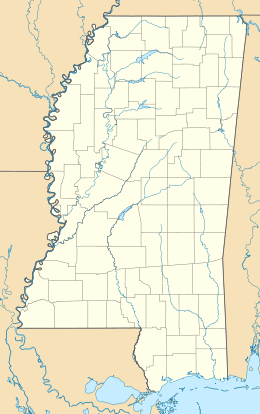Cat Island (Mississippi)

 Dunes on the south side of Cat Island | |
 Historical map of the changing geomorphology of Cat Island | |
| Geography | |
|---|---|
| Location | Gulf of Mexico |
| Coordinates | 30°13′N 89°06′W / 30.217°N 89.100°W |
| Archipelago | Mississippi–Alabama barrier islands |
| Administration | |
| State | Mississippi |
| County | Harrison County |
Cat Island is a barrier island off the Gulf Coast of the United States, one of the Mississippi–Alabama barrier islands. The island's name comes from French explorers who mistook raccoons (which were not introduced to Europe until the 20th century) for cats. It is unknown who discovered Cat Island. It is within the jurisdiction of Harrison County, Mississippi. The western half and southern tip of the island is part of the Gulf Islands National Seashore.
Formation and history
[edit]Cat Island is a unique "T-shaped" island created by colliding Gulf of Mexico currents. Unlike the other Mississippi islands, Cat Island's sand beaches are backed by dense forests of slash pines and live oaks. Due to the dredging of the Gulfport ship channel, however, Cat Island has lost its natural westward flow of sediment which provided material for the island to combat erosion. Bayous and marshes on Cat Island are home to alligators and refuge to migratory birds.
During World War II, the island was base for the Cat Island War Dog Reception and Training Center where Americans sent family dogs to be trained by the U.S. Army Signal Corps for military service. The dogs were trained to sniff out Japanese Americans because of the belief that those of Japanese ethnicity had a distinct odor. This particular experiment was totally unsuccessful though dogs proved effective as an aid to sentries and advance scouts.[1] This period of the island's history was featured on a June 2009 episode of the PBS series History Detectives.[2]
The western half and southern tip of the island became part of the Gulf Islands National Seashore in 2002. The remainder of the island, including most of the beach, is still privately owned. The eastern beach is owned by BP, who purchased it in April 2011 to use in assisting cleanup of the 2010 Deepwater Horizon oil spill.[3] In December 2016 Mississippi acquired the 492 acres that BP had purchased from the Brodie family in 2011. This section of East Beach was added to the Cat Island Coastal Preserve.[4]

In 2005 Hurricane Katrina shrank the island by eliminating the southern tip. During the foul weather associated with Hurricane Patricia a commercial fisherman reported abundant redfish in the flooded bayous of the island.[5]
See also
[edit]References
[edit]- ^ Quartermaster War Dog Program Archived 2013-01-20 at the Wayback Machine. US Army Quartermaster Foundation.
- ^ Zuber, Tukufu. "War Dog Letter". History Detectives, Season 7, Episode 1. Oregon Public Broadcasting.
- ^ Nelson, Karen (April 7, 2011). "BP buys east beach of Cat Island - Long Beach". Sun Herald. Archived from the original on 10 April 2011. Retrieved 29 April 2011.
- ^ Hattiesburg American Dec. 9, 2016 https://www.hattiesburgamerican.com/story/news/2016/12/09/miss-acquires-492-acres-cat-island-bp-deal/95219380/
- ^ Schindler, Sonny. (27 October 2015). "Outdoors Report:Flooded grass reds". Clarion Ledger. (Jackson). Retrieved 27 October 2015. Clarion Ledger website
Further reading
[edit]Cuevas, John (211). Cat Island: The History of a Mississippi Gulf Coast Barrier Island. McFarland. p. 205.
External links
[edit]- "Cat Island". Geographic Names Information System. United States Geological Survey. Retrieved 2006-04-13.
- "Initial Purchase of Land on Cat Island". Gulf Islands National Seashore. National Park Service. March 28, 2002. Archived from the original on February 14, 2005. Retrieved 2006-05-04.
- "Hurricane Katrina Erodes the U.S. Gulf Coast". NASA Earth Observatory. Archived from the original on 2006-10-04. Retrieved 2006-05-04.
